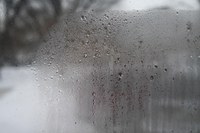Window Condensation Common Problem
(Click the image below to view a high-resolution image that can be downloaded)
The colder the weather outside, the greater the chances of window condensation inside.
“A thin film of moisture is nothing more than a nuisance, but as the air continues to cool, more moisture forms on the window, which eventually can lead to damage to the window and surrounding wall as ice forms,” says Carl Pedersen, North Dakota State University Extension Service energy educator. “Excess moisture also can be a breeding ground for mold.”
Condensation can occur even though you made sure to seal your house properly last fall by running a fresh bead of caulk around the windows and replacing worn-out weather stripping around the front door.
Air has an ability to hold different amounts of water vapor, depending on the temperature, according to Pedersen. The warmer the air, the more room for water. Colder air has less room for water molecules, so they start to stick together. When the heated air in your house comes in contact with the cold air next to your windows, it cools. The cooler air causes the excess moisture to stick to the window as condensation.
“The same thing happens on a glass of your favorite chilled beverage,” Pedersen says.
This excess moisture comes from a variety of sources. Each person in a house adds 3 pints of water vapor to the air every day just from breathing. Add to this the water from showers, cooking and laundry and it adds up quickly.
If you notice condensation on double- or triple-pane windows, you most likely have too much humidity in your house. You should strive for relative humidity levels around 40 percent in the winter. Any higher and you risk condensation and mold issues; any lower and the air is too dry. Air that is too dry can cause dry skin and nasal passages, which could lead to respiratory illness.
With a double-pane window, condensation should begin to appear when the outside temperature dips below zero if the relative humidity level in the house is 40 percent. With triple-glaze windows, condensation should not begin to show until the outside temperatures reach closer to minus 40 F.
If humidity levels are considerably higher than 40 percent, you can begin running vent fans in the bathroom and kitchen to reduce these levels. Just make sure the fans vent to the outside. Venting into the attic could cause unseen moisture problems, including mold growth, Pedersen says.
Many people use dehumidifiers, but they generally are ineffective if humidity levels are below 50 percent, which is common in the winter. If condensation is occurring on windows behind draperies, try leaving the drapes open at night.
“Unfortunately this causes energy losses, which need to be balanced with the decrease in window condensation,” Pedersen says.
Newer construction has created homes that are extremely airtight. The owners of these homes may want to invest in an air-to-air exchange system, which brings dry air in from the outside and replaces the warm, moist air in your home. These systems use a heat exchanger to salvage as much as 70 percent of the heat from the indoor air.
Some newer ideas being used involve installing low-volume ventilation fans is areas such as the bathroom. These fans either run continuously or are controlled by a humidistat. When the humidity rises above the desired level, the fan kicks in and runs until the lower level is achieved.
The NDSU Extension Service has developed a publication to explain the basics of air-to-air heat exchangers. Contact your local county Extension office for a copy or visit http://www.ndsu.edu/energy for information on this and many other energy-related topics.
NDSU Agriculture Communication - Jan. 14, 2011
| Source: | Carl Pedersen, (701) 231-5833, carl.pedersen@ndsu.edu |
|---|---|
| Editor: | Ellen Crawford, (701) 231-5391, ellen.crawford@ndsu.edu |


